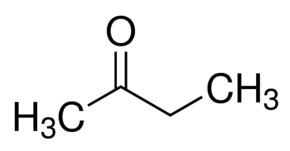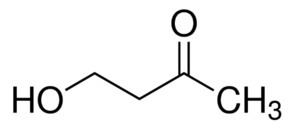Appearance Colorless liquid Boiling point 79.64 °C IUPAC ID Butan-2-one Melting point -86 °C | Formula C4H8O Density 805 kg/m³ Molar mass 72.11 g/mol Soluble in Water | |
 | ||
Thermodynamicdata Phase behavioursolid–liquid–gas | ||
Butanone, also known as methyl ethyl ketone (MEK), is an organic compound with the formula CH3C(O)CH2CH3. This colorless liquid ketone has a sharp, sweet odor reminiscent of butterscotch and acetone. It is produced industrially on a large scale, and also occurs in trace amounts in nature. It is soluble in water and is commonly used as an industrial solvent.
Contents
- Butanone meaning
- Production
- As a solvent
- As a plastic welding agent
- Other uses
- Flammability
- Health effects
- Regulation
- References

Butanone meaning
Production

Butanone may be produced by oxidation of 2-butanol. The dehydrogenation of 2-butanol using a catalyst is catalyzed by copper, zinc, or bronze:
CH3CH(OH)CH2CH3 → CH3C(O)CH2CH3 + H2
This is used to produce approximately 700 million kilograms yearly. Other syntheses that have been examined but not implemented include Wacker oxidation of 2-butene and oxidation of isobutylbenzene, which is analogous to the industrial production of acetone.

Both liquid-phase oxidation of heavy naphtha and the Fischer-Tropsch reaction produce mixed oxygenate streams, from which 2-butanone is extracted by fractionation.
Butanone is biosynthesized by some trees and found in some fruits and vegetables in small amounts. It is released to the air from car and truck exhausts.
As a solvent
Butanone is an effective and common solvent and is used in processes involving gums, resins, cellulose acetate and nitrocellulose coatings and in vinyl films. For this reason it finds use in the manufacture of plastics, textiles, in the production of paraffin wax, and in household products such as lacquer, varnishes, paint remover, a denaturing agent for denatured alcohol, glues, and as a cleaning agent. It has similar solvent properties to acetone but boils at a higher temperature and has a significantly slower evaporation rate. Butanone is also used in dry erase markers as the solvent of the erasable dye.
As a plastic welding agent
As butanone dissolves polystyrene and many other plastics, it is sold as "model cement" for use in connecting parts of scale model kits. Though often considered an adhesive, it is actually functioning as a welding agent in this context.
Other uses
Butanone is the precursor to methyl ethyl ketone peroxide, which is a catalyst for some polymerization reactions such as crosslinking of unsaturated polyester resins.
Flammability
Butanone can react with most oxidizing materials, and can produce fires. It is moderately explosive; it requires only a small flame or spark to cause a vigorous reaction. Butanone fires should be extinguished with carbon dioxide, dry agents, or alcohol-resistant foam. Concentrations in the air high enough to be flammable are intolerable to humans due to the irritating nature of the vapor.
Health effects
Butanone is an irritant, causing irritation to the eyes and nose of humans. Serious health effects in animals have been seen only at very high levels. These included skeletal birth defects and low birth weight in mice, when they inhaled it at the highest dose tested (3000 ppm for 7 hours/day). There are no long-term studies with animals breathing or drinking it, and no studies for carcinogenicity in animals breathing or drinking it. There is some evidence that methyl ethyl ketone can potentiate the toxicity of other solvents, in contrast to the calculation of mixed solvent exposures by simple addition of exposures. As of 2010, some reviewers advised caution in using methylethyl ketone because of reports of neuropsychological effects.
Butanone is listed as a Table II precursor under the United Nations Convention Against Illicit Traffic in Narcotic Drugs and Psychotropic Substances.
Regulation
Emission of butanone was regulated in the US as a hazardous air pollutant, because it is a volatile organic compound contributing to the formation of tropospheric (ground-level) ozone. In 2005, the U. S. Environmental Protection Agency removed butanone from the list of hazardous air pollutants (HAPs).
